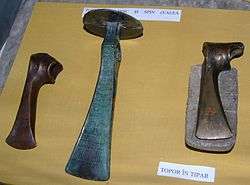Wietenberg culture
The Wietenberg culture was a Middle Bronze Age archeological culture in Central Transylvania that roughly dates to 2200–1600/1500 BCE. Represented a local variant of Usatovo culture and was replaced by Noua culture. Its name was coined after the eponymic Wietenberg Hill near Sighișoara.
| Geographical range | Romania (Transylvania) |
|---|---|
| Period | Bronze Age |
| Dates | c. 2200 BC – 1500 BC |
| Preceded by | Coțofeni culture |
| Followed by | Noua culture |

Wietenberg culture battle axes found at Valea Chioarului, Maramureș County, Romania. In display at the National Museum of Transylvanian History, Cluj-Napoca
People of this culture traded with the Mycenaeans. Burial sites contain bronze battle axes and maces with stone heads. Pottery consists of amphorae with spiral and meandric ornament.

On the left, Mycenaean bronze sword found at Dumbrăvioara, Mureş County, Romania. On the bottom right, Wietenberg culture battle axes found at Valea Chioarului, Maramureș County, Romania. The image also includes pottery (top left) and fibulae (top middle). In display at the National Museum of Transylvanian History, Cluj-Napoca.
By 1964 about 200 settlements of this culture were discovered.
See also
- Bronze Age in Romania
- Coţofeni culture
- Basarabi culture
- Otomani culture
- Pecica culture
- Prehistory of Transylvania
- Prehistoric Romania
- Rotbav, Archaeological Site
Notes
References
Wietenberg ohne Mykene?Gedanken zu Herkunft und Bedeutung der Keramikverzierung der Wietenberg-Kultur von Laura Dietrich, Berlin, und Oliver Dietrich, Berlin
External links
| Wikimedia Commons has media related to Wietenberg culture. |
This article is issued from Wikipedia. The text is licensed under Creative Commons - Attribution - Sharealike. Additional terms may apply for the media files.